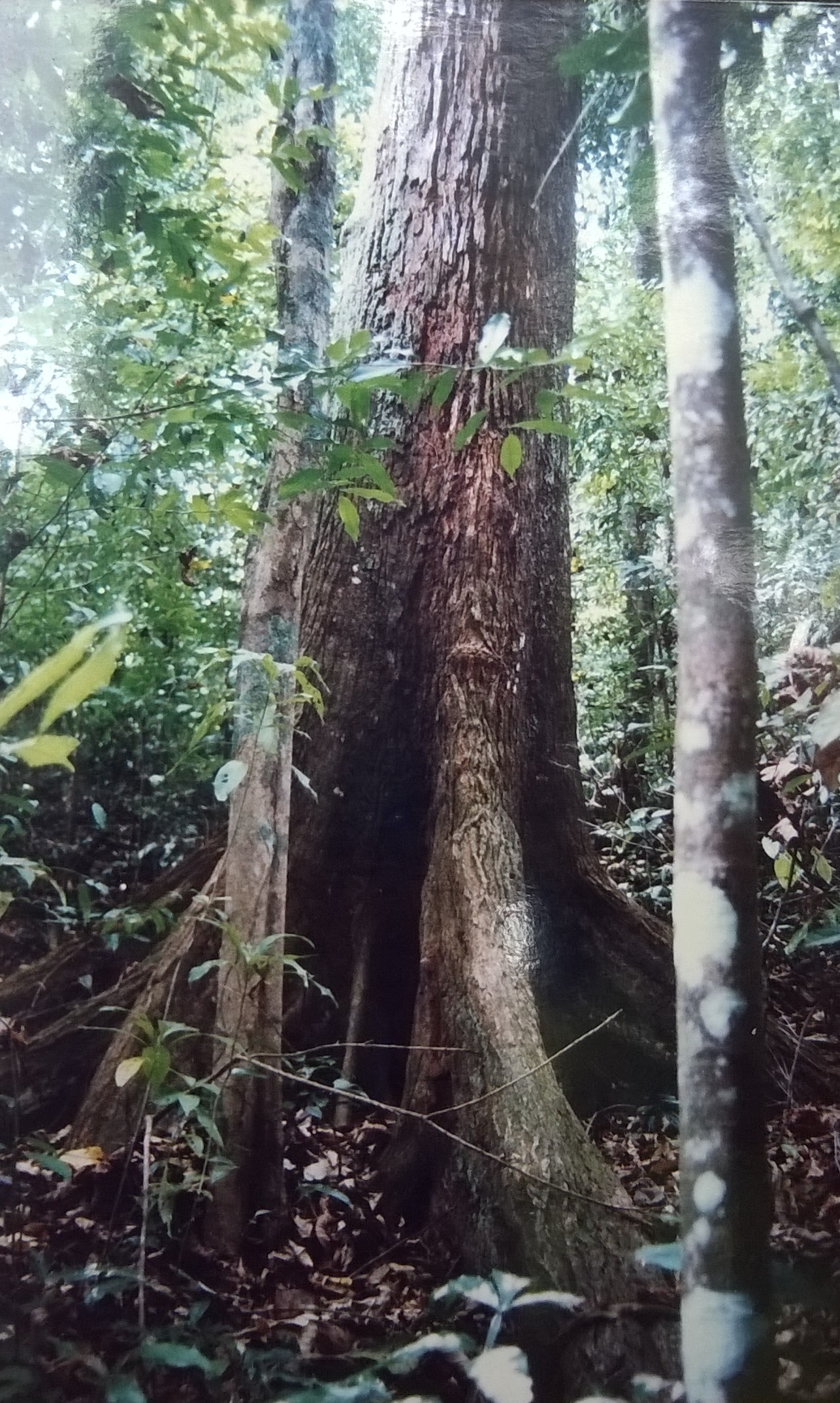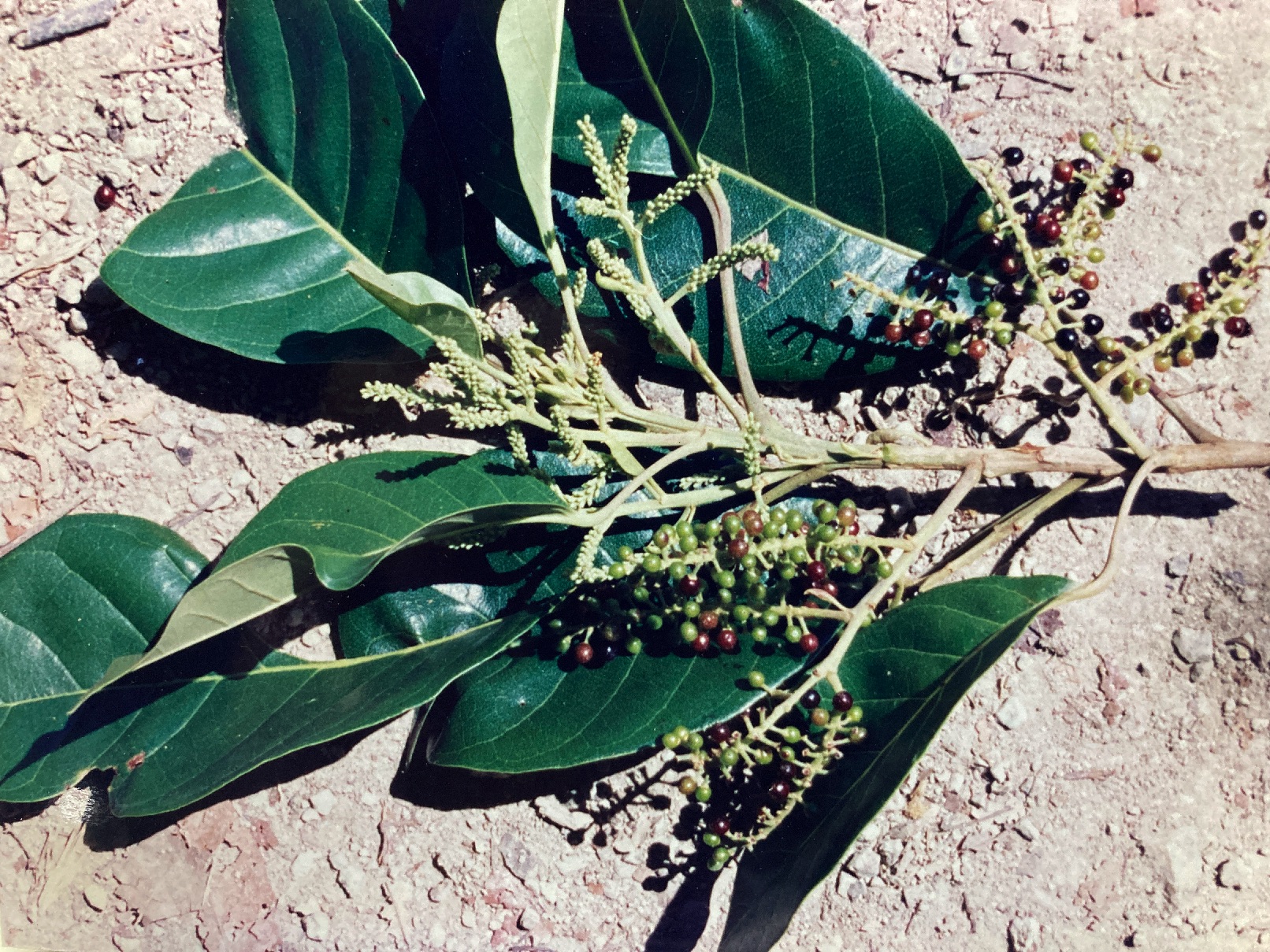Hyeronima alchorneoides Allemao
Euphorbiaceae PILON, ZAPATERO
Occasional evergreen canopy tree (30-35 m) distributed thinly throughout the Pacific slope´s humid coastal forests. Pilon is an appreciated timber tree, yielding strong and heavy wood for construction, however its ecological role – providing forage to a wide variety of birds and mammals – makes this tree more valuable left standing.
Description: Pilon has a stout (>1m), cylindrical, and straight trunk that rises vertically to the canopy layer before branching. There, the upwardly-angled limbs give rise to a characteristically wide and hemispherical crown, in which the foliage is confined to the outermost layer of twigs. Buttresses, as such, are not present but large, rounded roots (often over 30 cm in diameter) do emerge from the massive bole just above the soil. These travel considerable distances along the surface of the forest floor, tracing out snake-like, meandering paths before disappearing from view. The bark is thick, vertically fissured, and has a hallmark, rusty or burnt-orange hue that is most notable within the deep grooves and near the base of the tree. Moss is often found growing on the base of these boles as well, seeming to prefer Pilon to other large species. Uniquely colored, thick, blood-red sap lies underneath the bark of boles, branches and twigs and is also found in the dark heartwood.
Leaves are simple and alternate, arranged in whorl-like clusters around branch tips. Their most readily visible feature is a long, grooved petiole (3-6 cm), possessing a marked, elbow-shaped bend or crook just before the blade. Also unusual, the leaves have a bicolored appearance thanks to a dense but fine covering of tan pubescence on their lower surfaces, as well as on petioles and twigs. Blades are widely elliptical in shape – sometimes nearly orbicular – with prominent, pinnate venation and short drip tips. Varying widely in size, leaf dimensions range from 13-22 cm in length and 6-11 cm in width. Old leaves redden before falling and the tree’s green crown, mottled with patches of scarlet, is an identifying characteristic for this species.
Flowers are imperfect, with male and female blossoms borne on different trees (Pilon is dioecious). Both types of flowers grow from leaf axils on large (7 cm), branched panicles. They are tiny (2 mm in diameter), green, and petal-less, with only a few short stamens (male) or vestigial staminate appendages (female) to adorn them. Flowering periods are complex and bi-annual, with male trees blossoming for much more extended periods than females. The main flowering season for male trees begins in August and lasts through November, while female trees are fertile only from late September through October. Males resume flowering in February and continue through early April, with females participating in late February.
Fruits are produced rapidly after the females flower. Each panicle supports tens of small (3 mm – spherical drupes that ripen from green to a deep red wine color. A single white seed (1.5 mm) is contained within the juicy pulp. Harvests are also bi-annual and their intensity varies from season to season. Each begins about six weeks after flowering, the first lasting from December through January and the second from mid-May through mid-June.
Similar Species: With its reddish-brown trunk, great stature, nearly omnipresent male flowers, and large, long-petioled leaves that turn red in the canopy, Pilon is relatively easy to identify in the field. Other species with long-petioled, elliptical leaves include Dendropanax arboreus and Capparis discolor, however these are much smaller, understory or subcanopy trees whose bark characteristics bear no resemblance to those of Pilon.
Natural History: Pilon flowers are visited by bees, wasps and other insects, seen swarming thickly around the inflorescences on clear, sunny days. Fruits are much sought after by local fauna – with both White-faced and Squirrel monkeys included in this category. The monkeys often break the thin twigs carrying both the fruit panicles and the leaf whorls, and the discarded remnants of these branches frequently litter the ground underneath fruiting Pilons. Birds, such as saltators, also forage in Pilon trees during harvest.
Pilon trees demonstrate one of two opposing reproductive tendencies in plants with their habit of fabricating huge quantities of small fruits and seeds. In general, plants have a limited amount of energy to invest in reproduction and so the number of seeds and fruits that any species can form and disseminate is inversely proportional to fruit size. Usually, a tree producing large seeds (most often found inside large fruits) can only afford to make a relatively small number of them. However, the larger seed also means more stored food (most of a seed’s mass is stored food – the embryo represents only a tiny fraction of its total weight) for the tiny seedling. Coming at a time when it is not able to do much photosynthesis for itself, the presence of this energy source enhances the seedling’s chances of survival. Trees producing mass quantities of small seeds forego this advantage. Typically, their seedlings are still small and weak when food stores run out. However, they compensate for this decreased chance of individual seedling survival by drastically increasing the number of times it is applied. Apparently, both of these reproductive strategies are successful, since many trees of each type thrive in tropical forests.
The apparent preference of mosses for Pilon bark can perhaps be explained by its water-holding capacity. Porous, especially near the tree’s base, this thick bark can absorb much moisture. Deep in the lower layers of the primary forest where there is no sunlight, this bark stands little chance of drying out. Mosses, non-vascular plants possessing no water-conserving cuticle over their exposed tissues, need a constant supply of water in order to avoid desiccation. The thick bark of Pilon trees can provide a steady and ample water supply in a way that few other trees can.
Uses: Pilon is renown for its very heavy, coarse-grained, dark maroon-colored wood that is used extensively in house construction. Obviously, its importance to forest animals makes Pilon a vital ecological component of the forests that it inhabits.
Distribution: In Costa Rica, populations of this species are protected in Manuel Antonio and Corcovado National Parks. It ranges from Mexico through Central America and into South America.




